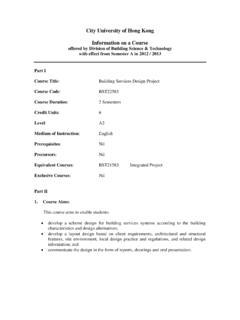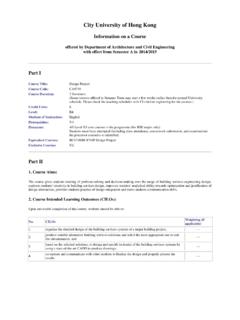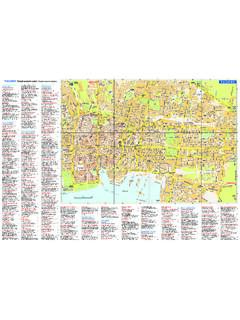Transcription of 9. Ion Implantation
1 Chapter 9 1 1 CHAPTER 9: Ion Implantation Ion Implantation is a low-temperature technique for the introduction of impurities (dopants) into semiconductors and offers more flexibility than diffusion. For instance, in MOS transistors, ion Implantation can be used to accurately adjust the threshold voltage. In ion Implantation , dopant atoms are volatilized, ionized, accelerated, separated by the mass-to-charge ratios, and directed at a target that is typically a silicon substrate. The atoms enter the crystal lattice, collide with the host atoms, lose energy, and finally come to rest at some depth within the solid. The average penetration depth is determined by the dopant, substrate materials, and acceleration energy.
2 Ion Implantation energies range from several hundred to several million electron volts, resulting in ion distributions with average depths from < 10 nm to 10 . Doses range from 1011 atoms/cm2 for threshold adjustment to 1018 atoms/cm2 for buried dielectric formation. Ion Stopping As each implanted ion impinges onto the target, it undergoes a series of collisions with the host atoms until it finally stops at some depth, as depicted in Figure Since the initial ion energy, typically several tens of keV, is much higher than lattice binding energies, the ion scattering process can be simulated based on elastic collisions between pairs of nuclei while ignoring the relatively weak lattice forces.
3 A second component of scattering comes from inelastic collisions with electrons in the target. The total stopping power S of the target, defined by the energy loss (E) per unit path length (x) of the ion, is the sum of these two terms: SdEdxdEdxnuclearelectronic (Equation ) Figure shows the relative distribution to S of each of the terms over a wide energy range. Energies typical for ion Implantation , 10 to 200 keV, fall at the far left of the figure, a region dominated by nuclear stopping. Chapter 9 2 2 Figure : Monte Carlo calculation of 128 ion trajectories for 50 keV boron implanted into silicon. Figure : Nuclear and electronic components of the ion stopping power as a function of ion velocity.
4 The quantity vo is the Bohr velocity, oq 42, and Z1 is the ion atomic number. Chapter 9 3 3 Nuclear stopping is caused by a collision between two atoms, and can be described by classical kinematics. If the atoms were bare nuclei, then at a separation r, the coulombic potential between them would be: Vrqzzrco 2124 (Equation ) where z1 and z2 are the atomic number of the implanted and target atoms, respectively, o is the permittivity, and q is the electronic charge. In reality, electrons screen the nuclear charge and a screening function, fs(r), must be included such that: V(r) = Vc(r) fs(r) (Equation ) Given the interaction potential, the equations of motion of atoms can be integrated to yield the scattering angle for any incident ion trajectory.
5 Working in the center-of-mass frame, the result is: TMMMME 42121222sin (Equation ) where T is the energy lost by the incoming ion, E is the energy of the ion, is the scattering angle, and M1 and M2 are the atomic mass numbers of the ion and target atom, respectively. The rate of energy loss to nuclear collisions per unit path length can be calculated by summing the energy loss multiplied by the probability of that collision occurring. If the maximum possible energy transfer in a collision is Tmax and there are N target atoms per unit volume, then SdEdxNTdnnuclearT 0max (Equation ) where d is the differential cross section. Nuclear stopping is elastic, and so energy lost by the incoming ion is transferred to the target atom that is subsequently recoiled away from its lattice site, thus creating a damage or defect site.
6 Electronic stopping is caused by the interaction between the incoming ion and the electrons in the target. The theoretical model is quite complex, but in the low energy regime, the stopping is similar to a viscous drag force and is proportional to the ion velocity. Electronic stopping is inelastic. The energy loss by incident ions is dissipated through the electron cloud into thermal vibrations of the target. Chapter 9 4 4 Range Distributions Each implanted ion traverses a random path as it penetrates the target, losing energy by nuclear and electronic stopping. Since Implantation doses are usually higher than 1012 ions/cm2, ion trajectories can be predicted employing statistical means. The average total path length is called the range R, which is composed of both lateral and vertical motions.
7 The average depth of the implanted ions is called the projected range Rp, and the distribution of the implanted ions about that depth can be approximated as Gaussian with a standard deviation p (or Rp). The lateral motion of the ions leads to a lateral Gaussian distribution with a standard deviation . These parameters are illustrated schematically in Figure Far from the mask edge, the lateral motion can be ignored, and n(x), the ion concentration at depth x, can be written as: nxnxRopp exp222 (Equation ) where no is the peak concentration, Rp is the projected range, and p is the standard deviation. If the total implanted dose is , integrating Equation gives an expression for the peak concentration no: nopp 204.
8 (Equation ) In general, an arbitrary distribution can be characterized in terms of its moments. The normalized first moment of an ion distribution is the projected range, Rp. The second moment is the standard deviation, p. The third moment is the skewness, , whereas the fourth moment, kurtosis, is designated . Qualitatively, skewness is a measure of the asymmetry of the distribution. Positive skewness places the peak of the distribution closer to the surface than Rp. Kurtosis is an indication of how flat the top of a distribution is. A true Gaussian distribution has a skewness of 0 and a kurtosis of 3. Several different distributions have been employed to give a more accurate fit to the moments of an ion implant distribution than is possible using a Gaussian.
9 The most popular of these is the Pearson IV fit. Figure compares experimental boron profiles under non-channeling conditions with fitted distributions for energies between 30 keV and 800 keV. As the energy is increased, the profiles become more negatively skewed and deviate more Chapter 9 5 5 significantly from a true Gaussian. For heavier ions ( arsenic), the profiles at low energies have a positive skewness which decreases more slowly but can also become negative for sufficiently high energies. The nature of this skewness can be explained by increased electronic stopping for faster moving ions, that is, in the pre - peak or pre - Rp region. Table lists the range and standard deviation data for boron in a variety of materials.
10 Figure : Schematic views of the ion range. (a) The total path length R is longer than the projected Rp. (b) The stopped atom distribution is two-dimensional Gaussian. Chapter 9 6 6 Figure : boron implanted atom distributions, comparing measured data points with four-moment (Pearson IV) and Gaussian fitted distributions. The boron was implanted into amorphous silicon without annealing. Table : boron ranges in various materials. 100 keV boron Implantation Material Symbol Density (g/cm3) Rp( ) p( ) Silicon Si 2968 735 Silicon dioxide SiO2 3068 666 Silicon nitride Si3N4 1883 408 Photoresist AZ111 C8H12O 10569 1202 Titanium Ti 2546 951 Titanium silicide TiSi2 2154 563 Tungsten W 824 618 Tungsten silicide WSi2 1440 555 Experimentally, it is relatively easy to unveil vertical atomic profiles.










